Economic Analysis of Trade Wars, Telecom Mergers, and Labour Policies
VerifiedAdded on 2021/02/22
|23
|4767
|81
Report
AI Summary
This report provides an economic analysis of three key areas: the US-China trade war, the proposed merger of Vodafone and TPG Telecom in Australia, and the impact of increasing the minimum wage rate in Australia. The first section examines the effects of US import tariffs on Chinese leather handbags, assessing their impact on consumer and producer surplus. It also analyzes the impact of tariffs on the price and market quantity of US-produced cars that rely on steel. The second section delves into the market structure and characteristics of the telecommunication industry in Australia, exploring the economic analysis behind the ACCC's concerns regarding the Vodafone-TPG merger and offering recommendations for the industry's market structure. The final section discusses economic theories related to increasing the minimum wage rate, its potential impact on the Australian labour market, and illustrates the effects on demand, supply, price, and quantity for a normal good in the Australian economy. The report uses economic principles and relevant data to provide a comprehensive overview of these significant economic issues.
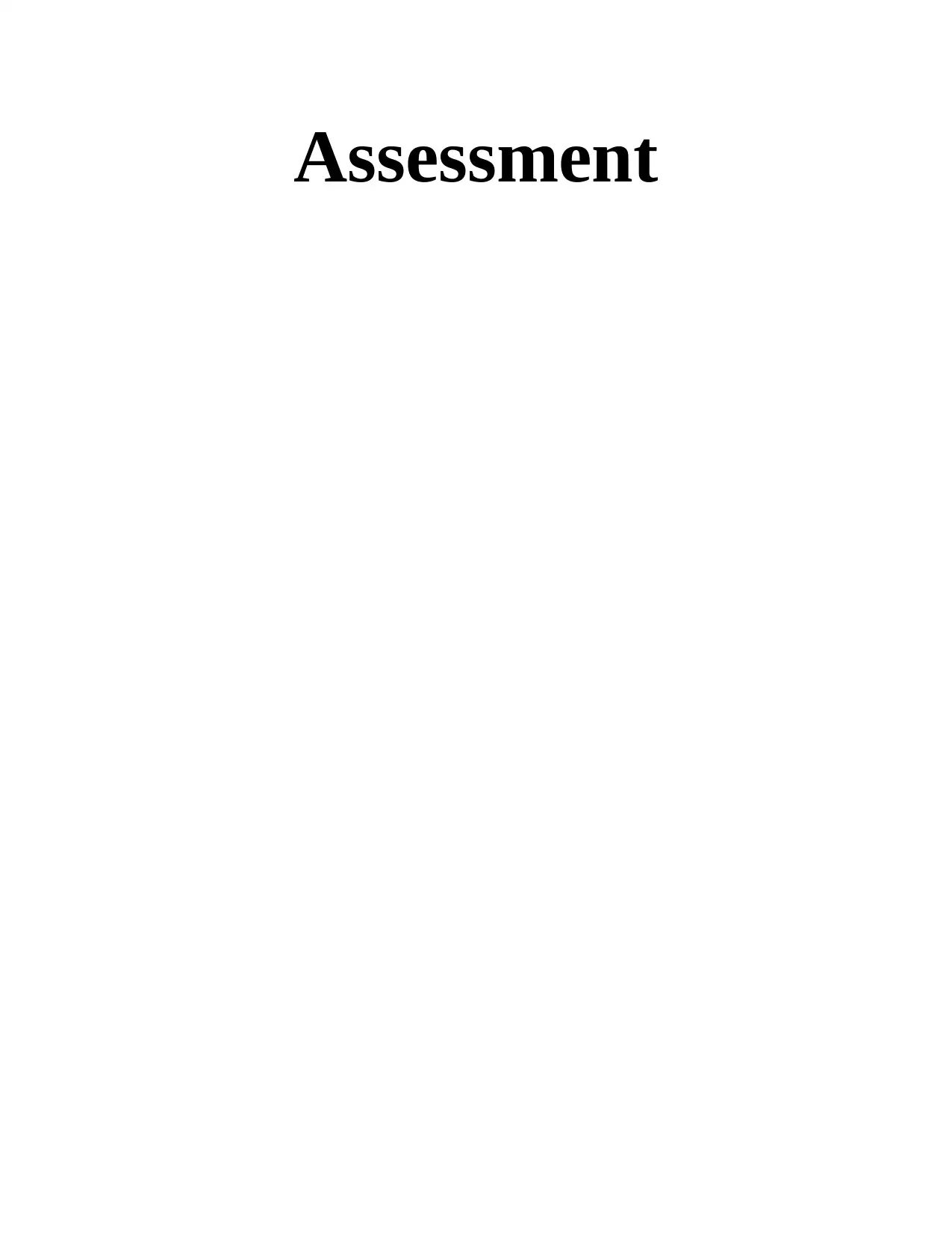
Assessment
Paraphrase This Document
Need a fresh take? Get an instant paraphrase of this document with our AI Paraphraser
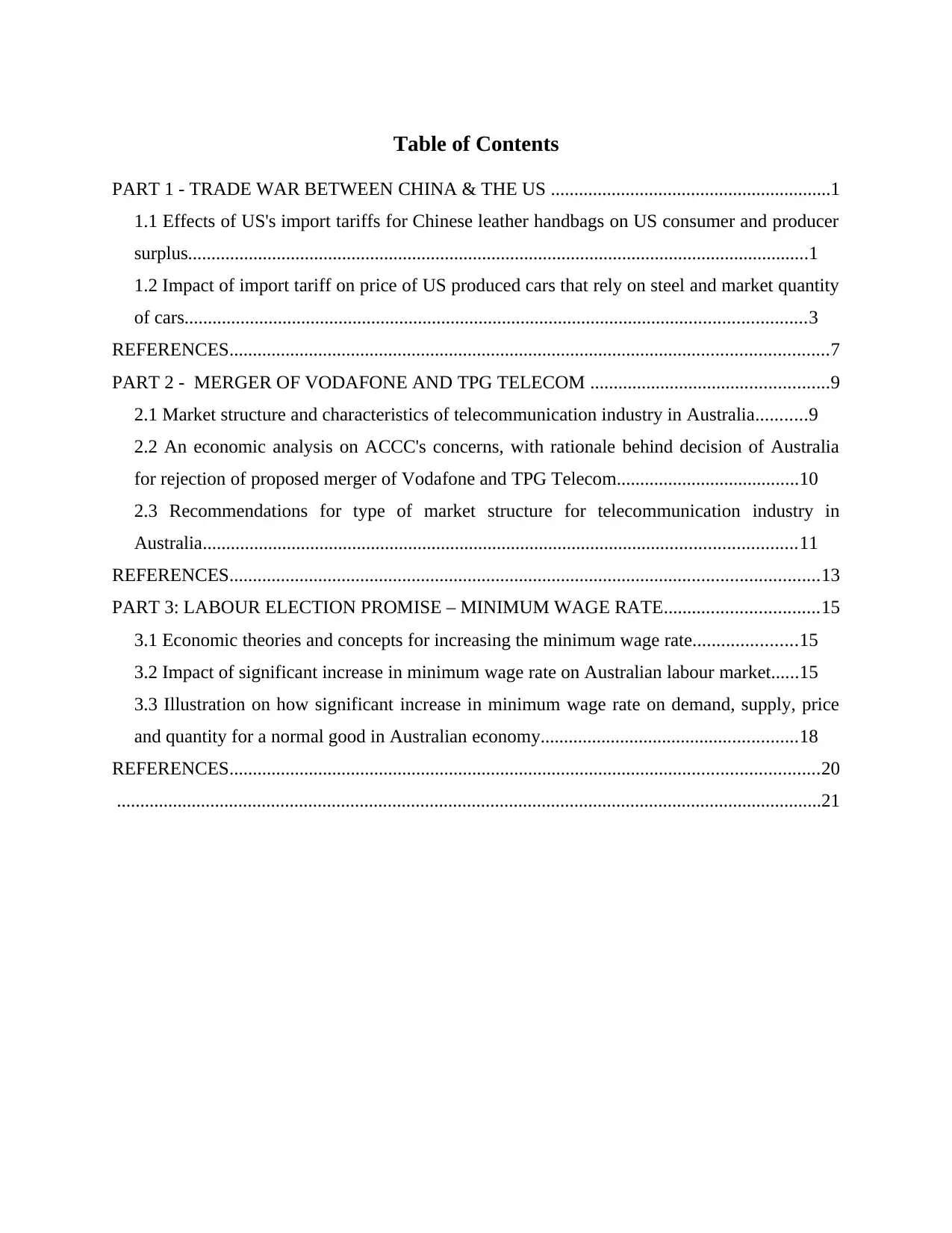
Table of Contents
PART 1 - TRADE WAR BETWEEN CHINA & THE US ............................................................1
1.1 Effects of US's import tariffs for Chinese leather handbags on US consumer and producer
surplus.....................................................................................................................................1
1.2 Impact of import tariff on price of US produced cars that rely on steel and market quantity
of cars.....................................................................................................................................3
REFERENCES................................................................................................................................7
PART 2 - MERGER OF VODAFONE AND TPG TELECOM ...................................................9
2.1 Market structure and characteristics of telecommunication industry in Australia...........9
2.2 An economic analysis on ACCC's concerns, with rationale behind decision of Australia
for rejection of proposed merger of Vodafone and TPG Telecom.......................................10
2.3 Recommendations for type of market structure for telecommunication industry in
Australia...............................................................................................................................11
REFERENCES..............................................................................................................................13
PART 3: LABOUR ELECTION PROMISE – MINIMUM WAGE RATE.................................15
3.1 Economic theories and concepts for increasing the minimum wage rate......................15
3.2 Impact of significant increase in minimum wage rate on Australian labour market......15
3.3 Illustration on how significant increase in minimum wage rate on demand, supply, price
and quantity for a normal good in Australian economy.......................................................18
REFERENCES..............................................................................................................................20
.......................................................................................................................................................21
PART 1 - TRADE WAR BETWEEN CHINA & THE US ............................................................1
1.1 Effects of US's import tariffs for Chinese leather handbags on US consumer and producer
surplus.....................................................................................................................................1
1.2 Impact of import tariff on price of US produced cars that rely on steel and market quantity
of cars.....................................................................................................................................3
REFERENCES................................................................................................................................7
PART 2 - MERGER OF VODAFONE AND TPG TELECOM ...................................................9
2.1 Market structure and characteristics of telecommunication industry in Australia...........9
2.2 An economic analysis on ACCC's concerns, with rationale behind decision of Australia
for rejection of proposed merger of Vodafone and TPG Telecom.......................................10
2.3 Recommendations for type of market structure for telecommunication industry in
Australia...............................................................................................................................11
REFERENCES..............................................................................................................................13
PART 3: LABOUR ELECTION PROMISE – MINIMUM WAGE RATE.................................15
3.1 Economic theories and concepts for increasing the minimum wage rate......................15
3.2 Impact of significant increase in minimum wage rate on Australian labour market......15
3.3 Illustration on how significant increase in minimum wage rate on demand, supply, price
and quantity for a normal good in Australian economy.......................................................18
REFERENCES..............................................................................................................................20
.......................................................................................................................................................21
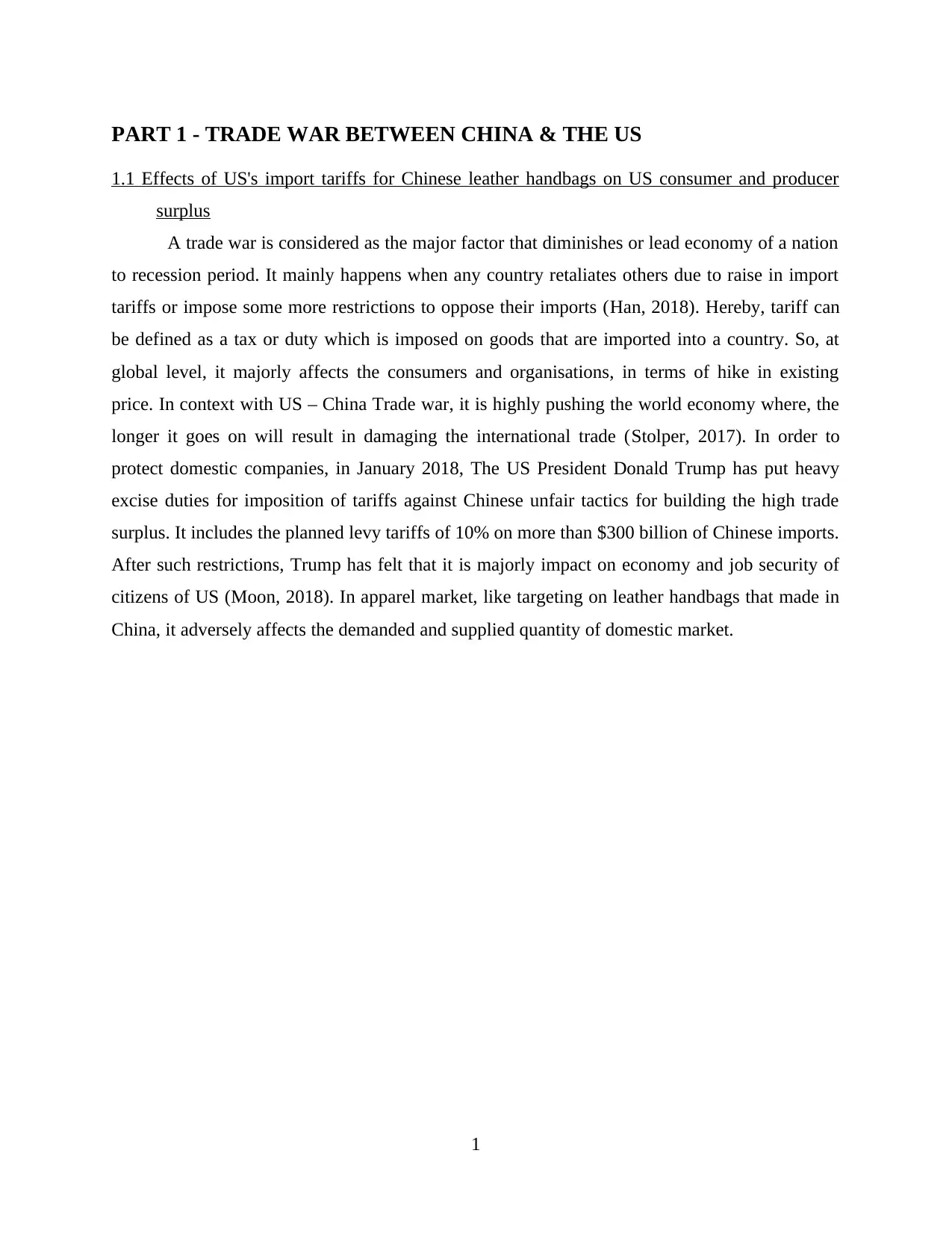
PART 1 - TRADE WAR BETWEEN CHINA & THE US
1.1 Effects of US's import tariffs for Chinese leather handbags on US consumer and producer
surplus
A trade war is considered as the major factor that diminishes or lead economy of a nation
to recession period. It mainly happens when any country retaliates others due to raise in import
tariffs or impose some more restrictions to oppose their imports (Han, 2018). Hereby, tariff can
be defined as a tax or duty which is imposed on goods that are imported into a country. So, at
global level, it majorly affects the consumers and organisations, in terms of hike in existing
price. In context with US – China Trade war, it is highly pushing the world economy where, the
longer it goes on will result in damaging the international trade (Stolper, 2017). In order to
protect domestic companies, in January 2018, The US President Donald Trump has put heavy
excise duties for imposition of tariffs against Chinese unfair tactics for building the high trade
surplus. It includes the planned levy tariffs of 10% on more than $300 billion of Chinese imports.
After such restrictions, Trump has felt that it is majorly impact on economy and job security of
citizens of US (Moon, 2018). In apparel market, like targeting on leather handbags that made in
China, it adversely affects the demanded and supplied quantity of domestic market.
1
1.1 Effects of US's import tariffs for Chinese leather handbags on US consumer and producer
surplus
A trade war is considered as the major factor that diminishes or lead economy of a nation
to recession period. It mainly happens when any country retaliates others due to raise in import
tariffs or impose some more restrictions to oppose their imports (Han, 2018). Hereby, tariff can
be defined as a tax or duty which is imposed on goods that are imported into a country. So, at
global level, it majorly affects the consumers and organisations, in terms of hike in existing
price. In context with US – China Trade war, it is highly pushing the world economy where, the
longer it goes on will result in damaging the international trade (Stolper, 2017). In order to
protect domestic companies, in January 2018, The US President Donald Trump has put heavy
excise duties for imposition of tariffs against Chinese unfair tactics for building the high trade
surplus. It includes the planned levy tariffs of 10% on more than $300 billion of Chinese imports.
After such restrictions, Trump has felt that it is majorly impact on economy and job security of
citizens of US (Moon, 2018). In apparel market, like targeting on leather handbags that made in
China, it adversely affects the demanded and supplied quantity of domestic market.
1
⊘ This is a preview!⊘
Do you want full access?
Subscribe today to unlock all pages.

Trusted by 1+ million students worldwide
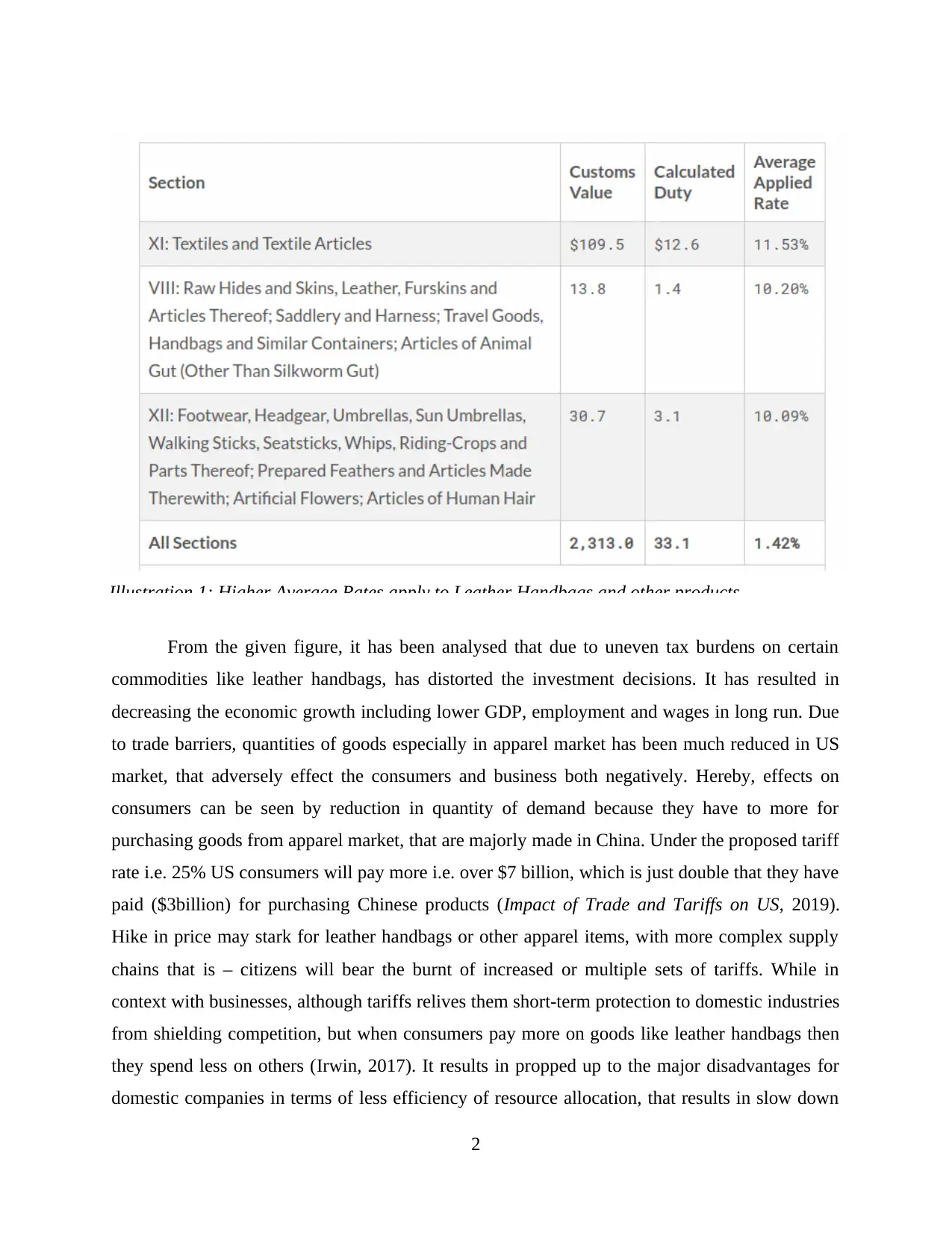
From the given figure, it has been analysed that due to uneven tax burdens on certain
commodities like leather handbags, has distorted the investment decisions. It has resulted in
decreasing the economic growth including lower GDP, employment and wages in long run. Due
to trade barriers, quantities of goods especially in apparel market has been much reduced in US
market, that adversely effect the consumers and business both negatively. Hereby, effects on
consumers can be seen by reduction in quantity of demand because they have to more for
purchasing goods from apparel market, that are majorly made in China. Under the proposed tariff
rate i.e. 25% US consumers will pay more i.e. over $7 billion, which is just double that they have
paid ($3billion) for purchasing Chinese products (Impact of Trade and Tariffs on US, 2019).
Hike in price may stark for leather handbags or other apparel items, with more complex supply
chains that is – citizens will bear the burnt of increased or multiple sets of tariffs. While in
context with businesses, although tariffs relives them short-term protection to domestic industries
from shielding competition, but when consumers pay more on goods like leather handbags then
they spend less on others (Irwin, 2017). It results in propped up to the major disadvantages for
domestic companies in terms of less efficiency of resource allocation, that results in slow down
2
Illustration 1: Higher Average Rates apply to Leather Handbags and other products
commodities like leather handbags, has distorted the investment decisions. It has resulted in
decreasing the economic growth including lower GDP, employment and wages in long run. Due
to trade barriers, quantities of goods especially in apparel market has been much reduced in US
market, that adversely effect the consumers and business both negatively. Hereby, effects on
consumers can be seen by reduction in quantity of demand because they have to more for
purchasing goods from apparel market, that are majorly made in China. Under the proposed tariff
rate i.e. 25% US consumers will pay more i.e. over $7 billion, which is just double that they have
paid ($3billion) for purchasing Chinese products (Impact of Trade and Tariffs on US, 2019).
Hike in price may stark for leather handbags or other apparel items, with more complex supply
chains that is – citizens will bear the burnt of increased or multiple sets of tariffs. While in
context with businesses, although tariffs relives them short-term protection to domestic industries
from shielding competition, but when consumers pay more on goods like leather handbags then
they spend less on others (Irwin, 2017). It results in propped up to the major disadvantages for
domestic companies in terms of less efficiency of resource allocation, that results in slow down
2
Illustration 1: Higher Average Rates apply to Leather Handbags and other products
Paraphrase This Document
Need a fresh take? Get an instant paraphrase of this document with our AI Paraphraser
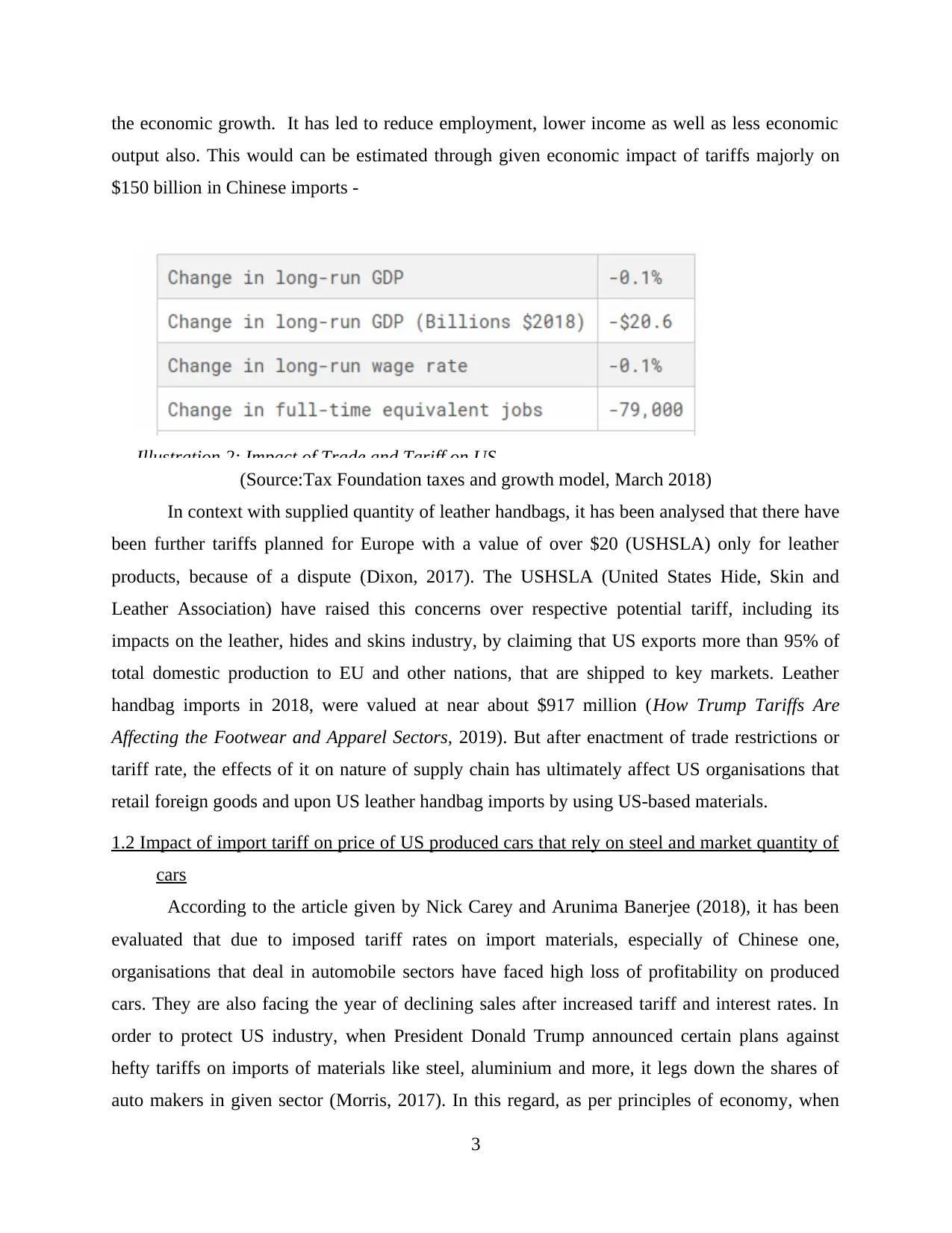
the economic growth. It has led to reduce employment, lower income as well as less economic
output also. This would can be estimated through given economic impact of tariffs majorly on
$150 billion in Chinese imports -
(Source:Tax Foundation taxes and growth model, March 2018)
In context with supplied quantity of leather handbags, it has been analysed that there have
been further tariffs planned for Europe with a value of over $20 (USHSLA) only for leather
products, because of a dispute (Dixon, 2017). The USHSLA (United States Hide, Skin and
Leather Association) have raised this concerns over respective potential tariff, including its
impacts on the leather, hides and skins industry, by claiming that US exports more than 95% of
total domestic production to EU and other nations, that are shipped to key markets. Leather
handbag imports in 2018, were valued at near about $917 million (How Trump Tariffs Are
Affecting the Footwear and Apparel Sectors, 2019). But after enactment of trade restrictions or
tariff rate, the effects of it on nature of supply chain has ultimately affect US organisations that
retail foreign goods and upon US leather handbag imports by using US-based materials.
1.2 Impact of import tariff on price of US produced cars that rely on steel and market quantity of
cars
According to the article given by Nick Carey and Arunima Banerjee (2018), it has been
evaluated that due to imposed tariff rates on import materials, especially of Chinese one,
organisations that deal in automobile sectors have faced high loss of profitability on produced
cars. They are also facing the year of declining sales after increased tariff and interest rates. In
order to protect US industry, when President Donald Trump announced certain plans against
hefty tariffs on imports of materials like steel, aluminium and more, it legs down the shares of
auto makers in given sector (Morris, 2017). In this regard, as per principles of economy, when
3
Illustration 2: Impact of Trade and Tariff on US
output also. This would can be estimated through given economic impact of tariffs majorly on
$150 billion in Chinese imports -
(Source:Tax Foundation taxes and growth model, March 2018)
In context with supplied quantity of leather handbags, it has been analysed that there have
been further tariffs planned for Europe with a value of over $20 (USHSLA) only for leather
products, because of a dispute (Dixon, 2017). The USHSLA (United States Hide, Skin and
Leather Association) have raised this concerns over respective potential tariff, including its
impacts on the leather, hides and skins industry, by claiming that US exports more than 95% of
total domestic production to EU and other nations, that are shipped to key markets. Leather
handbag imports in 2018, were valued at near about $917 million (How Trump Tariffs Are
Affecting the Footwear and Apparel Sectors, 2019). But after enactment of trade restrictions or
tariff rate, the effects of it on nature of supply chain has ultimately affect US organisations that
retail foreign goods and upon US leather handbag imports by using US-based materials.
1.2 Impact of import tariff on price of US produced cars that rely on steel and market quantity of
cars
According to the article given by Nick Carey and Arunima Banerjee (2018), it has been
evaluated that due to imposed tariff rates on import materials, especially of Chinese one,
organisations that deal in automobile sectors have faced high loss of profitability on produced
cars. They are also facing the year of declining sales after increased tariff and interest rates. In
order to protect US industry, when President Donald Trump announced certain plans against
hefty tariffs on imports of materials like steel, aluminium and more, it legs down the shares of
auto makers in given sector (Morris, 2017). In this regard, as per principles of economy, when
3
Illustration 2: Impact of Trade and Tariff on US
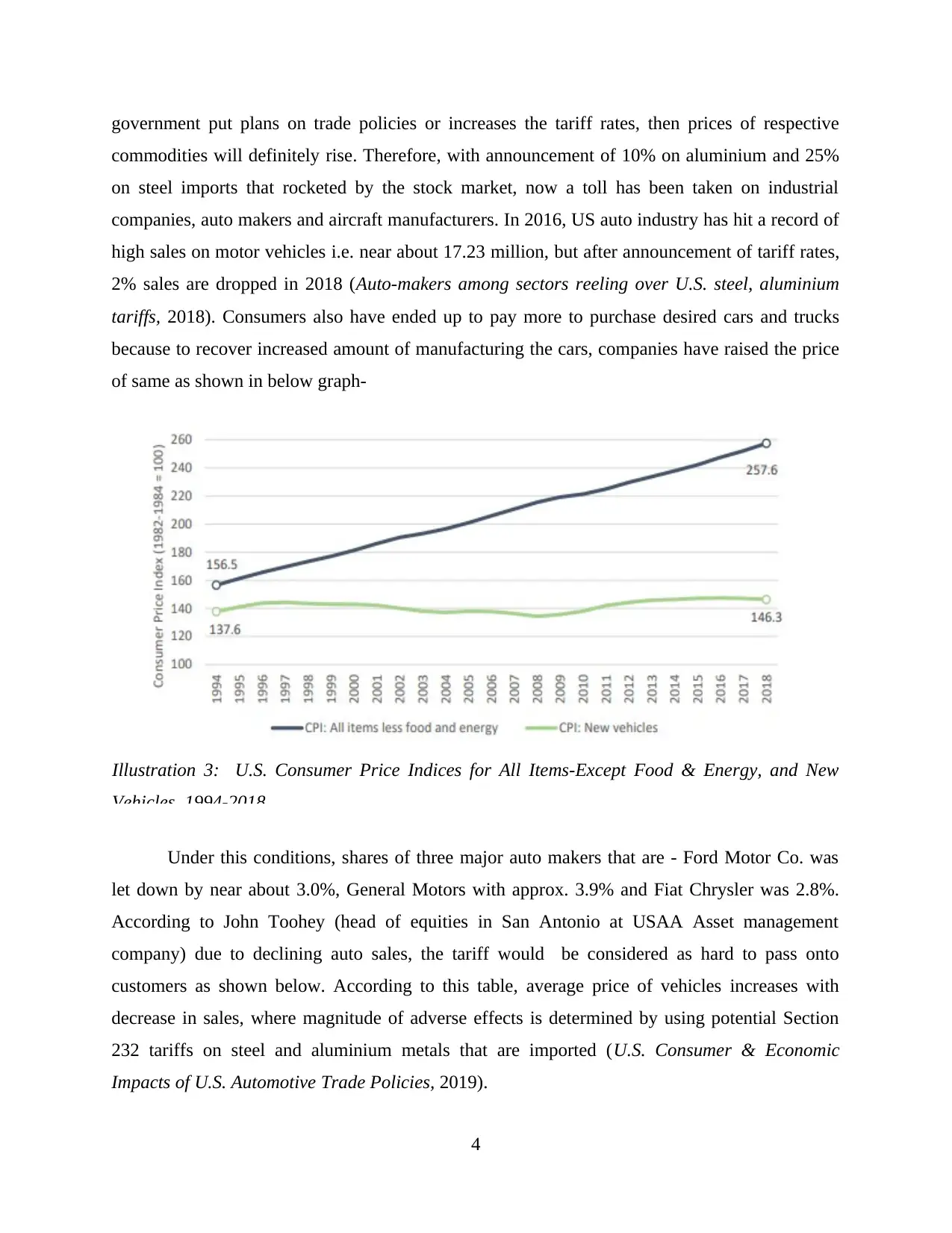
government put plans on trade policies or increases the tariff rates, then prices of respective
commodities will definitely rise. Therefore, with announcement of 10% on aluminium and 25%
on steel imports that rocketed by the stock market, now a toll has been taken on industrial
companies, auto makers and aircraft manufacturers. In 2016, US auto industry has hit a record of
high sales on motor vehicles i.e. near about 17.23 million, but after announcement of tariff rates,
2% sales are dropped in 2018 (Auto-makers among sectors reeling over U.S. steel, aluminium
tariffs, 2018). Consumers also have ended up to pay more to purchase desired cars and trucks
because to recover increased amount of manufacturing the cars, companies have raised the price
of same as shown in below graph-
Under this conditions, shares of three major auto makers that are - Ford Motor Co. was
let down by near about 3.0%, General Motors with approx. 3.9% and Fiat Chrysler was 2.8%.
According to John Toohey (head of equities in San Antonio at USAA Asset management
company) due to declining auto sales, the tariff would be considered as hard to pass onto
customers as shown below. According to this table, average price of vehicles increases with
decrease in sales, where magnitude of adverse effects is determined by using potential Section
232 tariffs on steel and aluminium metals that are imported (U.S. Consumer & Economic
Impacts of U.S. Automotive Trade Policies, 2019).
4
Illustration 3: U.S. Consumer Price Indices for All Items-Except Food & Energy, and New
Vehicles, 1994-2018
commodities will definitely rise. Therefore, with announcement of 10% on aluminium and 25%
on steel imports that rocketed by the stock market, now a toll has been taken on industrial
companies, auto makers and aircraft manufacturers. In 2016, US auto industry has hit a record of
high sales on motor vehicles i.e. near about 17.23 million, but after announcement of tariff rates,
2% sales are dropped in 2018 (Auto-makers among sectors reeling over U.S. steel, aluminium
tariffs, 2018). Consumers also have ended up to pay more to purchase desired cars and trucks
because to recover increased amount of manufacturing the cars, companies have raised the price
of same as shown in below graph-
Under this conditions, shares of three major auto makers that are - Ford Motor Co. was
let down by near about 3.0%, General Motors with approx. 3.9% and Fiat Chrysler was 2.8%.
According to John Toohey (head of equities in San Antonio at USAA Asset management
company) due to declining auto sales, the tariff would be considered as hard to pass onto
customers as shown below. According to this table, average price of vehicles increases with
decrease in sales, where magnitude of adverse effects is determined by using potential Section
232 tariffs on steel and aluminium metals that are imported (U.S. Consumer & Economic
Impacts of U.S. Automotive Trade Policies, 2019).
4
Illustration 3: U.S. Consumer Price Indices for All Items-Except Food & Energy, and New
Vehicles, 1994-2018
⊘ This is a preview!⊘
Do you want full access?
Subscribe today to unlock all pages.

Trusted by 1+ million students worldwide
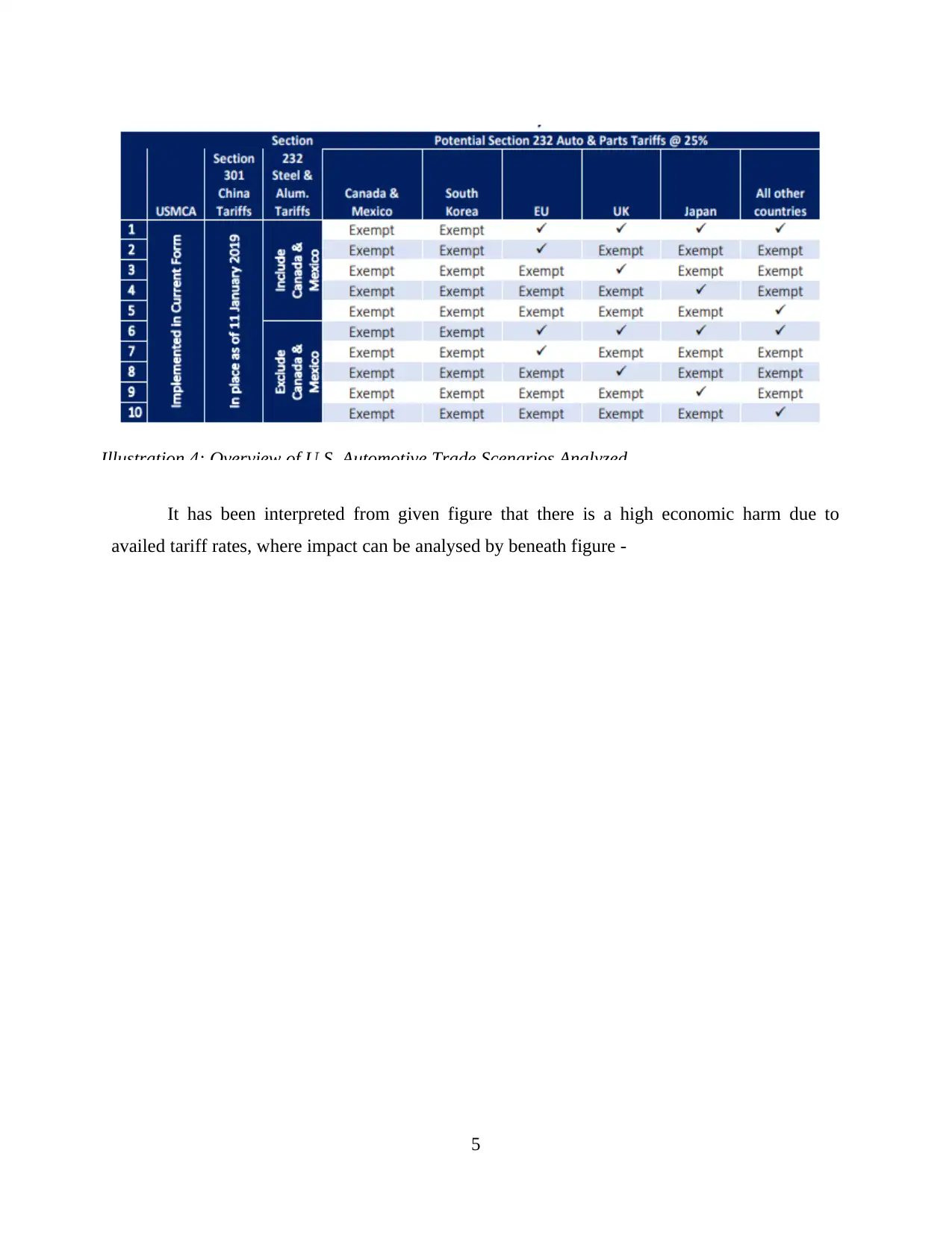
It has been interpreted from given figure that there is a high economic harm due to
availed tariff rates, where impact can be analysed by beneath figure -
5
Illustration 4: Overview of U.S. Automotive Trade Scenarios Analyzed
availed tariff rates, where impact can be analysed by beneath figure -
5
Illustration 4: Overview of U.S. Automotive Trade Scenarios Analyzed
Paraphrase This Document
Need a fresh take? Get an instant paraphrase of this document with our AI Paraphraser
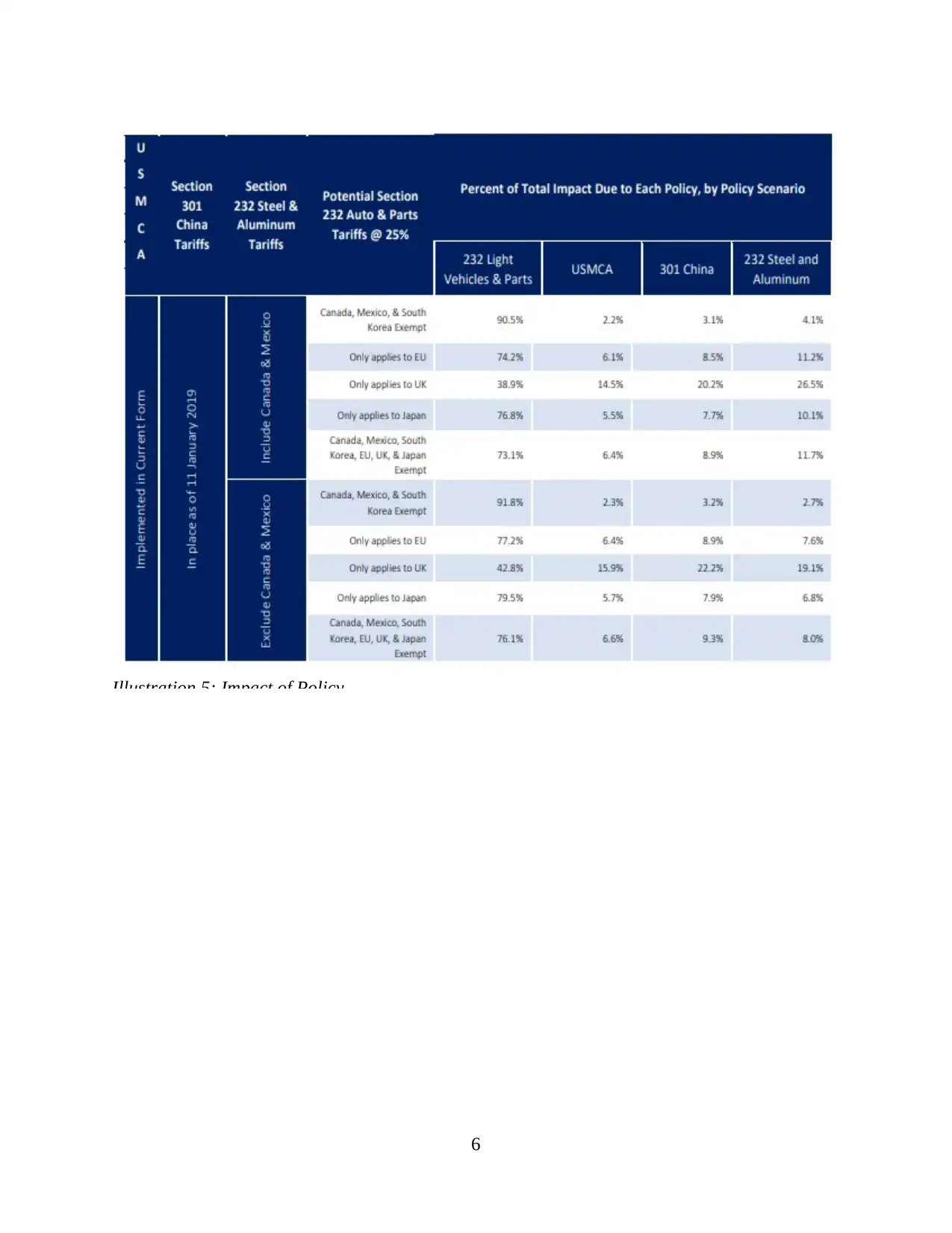
6
Illustration 5: Impact of Policy
Illustration 5: Impact of Policy
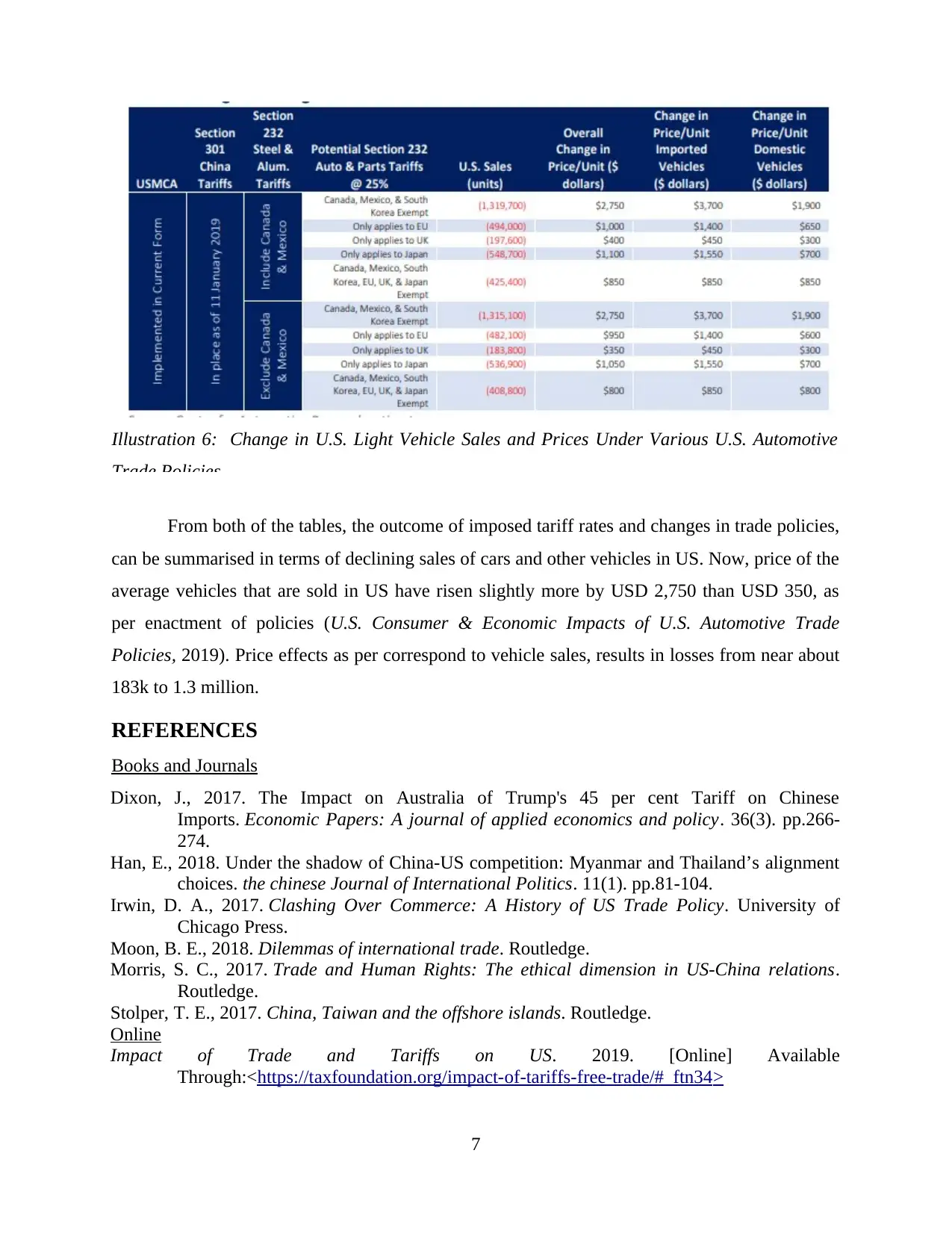
From both of the tables, the outcome of imposed tariff rates and changes in trade policies,
can be summarised in terms of declining sales of cars and other vehicles in US. Now, price of the
average vehicles that are sold in US have risen slightly more by USD 2,750 than USD 350, as
per enactment of policies (U.S. Consumer & Economic Impacts of U.S. Automotive Trade
Policies, 2019). Price effects as per correspond to vehicle sales, results in losses from near about
183k to 1.3 million.
REFERENCES
Books and Journals
Dixon, J., 2017. The Impact on Australia of Trump's 45 per cent Tariff on Chinese
Imports. Economic Papers: A journal of applied economics and policy. 36(3). pp.266-
274.
Han, E., 2018. Under the shadow of China-US competition: Myanmar and Thailand’s alignment
choices. the chinese Journal of International Politics. 11(1). pp.81-104.
Irwin, D. A., 2017. Clashing Over Commerce: A History of US Trade Policy. University of
Chicago Press.
Moon, B. E., 2018. Dilemmas of international trade. Routledge.
Morris, S. C., 2017. Trade and Human Rights: The ethical dimension in US-China relations.
Routledge.
Stolper, T. E., 2017. China, Taiwan and the offshore islands. Routledge.
Online
Impact of Trade and Tariffs on US. 2019. [Online] Available
Through:<https://taxfoundation.org/impact-of-tariffs-free-trade/#_ftn34>
7
Illustration 6: Change in U.S. Light Vehicle Sales and Prices Under Various U.S. Automotive
Trade Policies
can be summarised in terms of declining sales of cars and other vehicles in US. Now, price of the
average vehicles that are sold in US have risen slightly more by USD 2,750 than USD 350, as
per enactment of policies (U.S. Consumer & Economic Impacts of U.S. Automotive Trade
Policies, 2019). Price effects as per correspond to vehicle sales, results in losses from near about
183k to 1.3 million.
REFERENCES
Books and Journals
Dixon, J., 2017. The Impact on Australia of Trump's 45 per cent Tariff on Chinese
Imports. Economic Papers: A journal of applied economics and policy. 36(3). pp.266-
274.
Han, E., 2018. Under the shadow of China-US competition: Myanmar and Thailand’s alignment
choices. the chinese Journal of International Politics. 11(1). pp.81-104.
Irwin, D. A., 2017. Clashing Over Commerce: A History of US Trade Policy. University of
Chicago Press.
Moon, B. E., 2018. Dilemmas of international trade. Routledge.
Morris, S. C., 2017. Trade and Human Rights: The ethical dimension in US-China relations.
Routledge.
Stolper, T. E., 2017. China, Taiwan and the offshore islands. Routledge.
Online
Impact of Trade and Tariffs on US. 2019. [Online] Available
Through:<https://taxfoundation.org/impact-of-tariffs-free-trade/#_ftn34>
7
Illustration 6: Change in U.S. Light Vehicle Sales and Prices Under Various U.S. Automotive
Trade Policies
⊘ This is a preview!⊘
Do you want full access?
Subscribe today to unlock all pages.

Trusted by 1+ million students worldwide
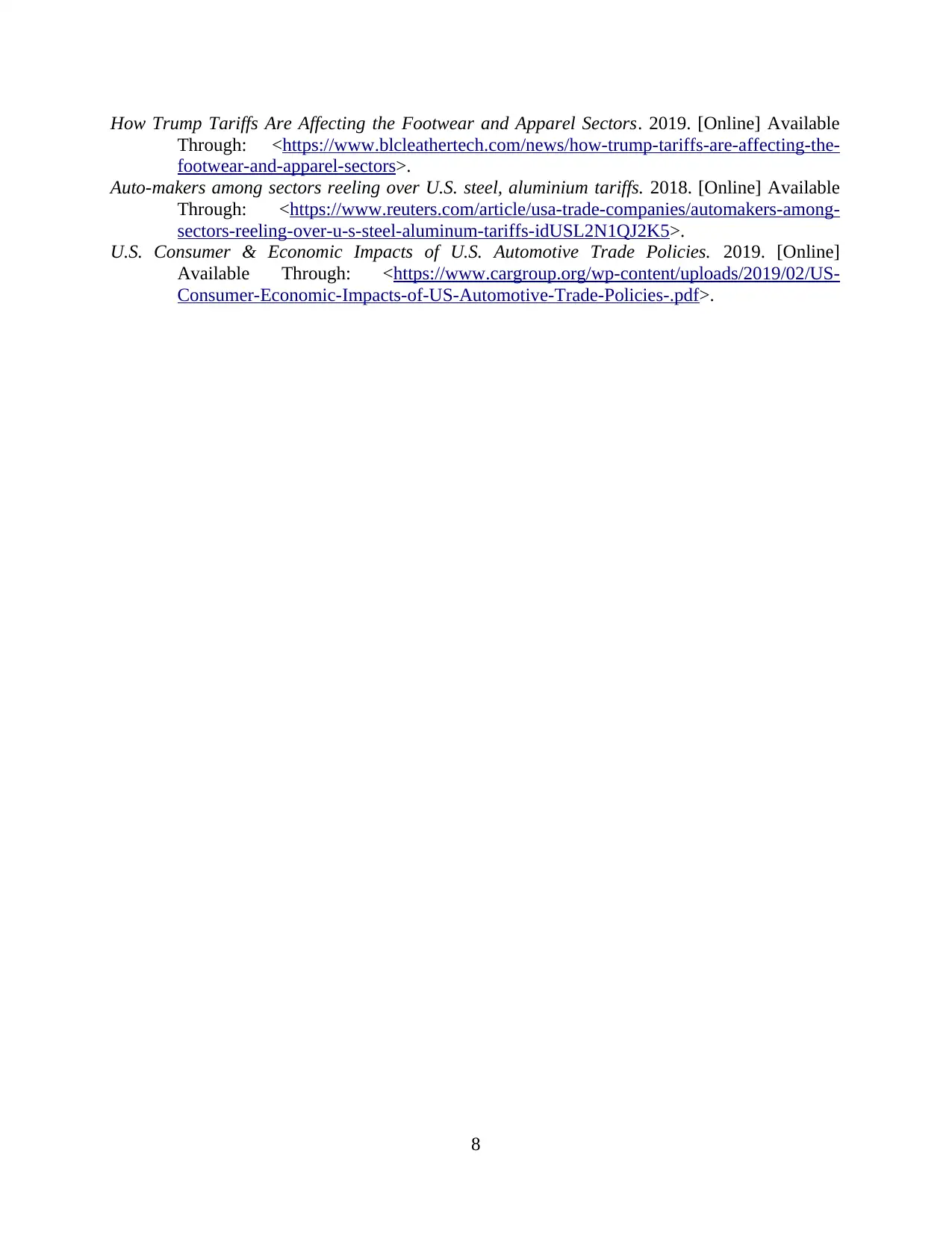
How Trump Tariffs Are Affecting the Footwear and Apparel Sectors. 2019. [Online] Available
Through: <https://www.blcleathertech.com/news/how-trump-tariffs-are-affecting-the-
footwear-and-apparel-sectors>.
Auto-makers among sectors reeling over U.S. steel, aluminium tariffs. 2018. [Online] Available
Through: <https://www.reuters.com/article/usa-trade-companies/automakers-among-
sectors-reeling-over-u-s-steel-aluminum-tariffs-idUSL2N1QJ2K5>.
U.S. Consumer & Economic Impacts of U.S. Automotive Trade Policies. 2019. [Online]
Available Through: <https://www.cargroup.org/wp-content/uploads/2019/02/US-
Consumer-Economic-Impacts-of-US-Automotive-Trade-Policies-.pdf>.
8
Through: <https://www.blcleathertech.com/news/how-trump-tariffs-are-affecting-the-
footwear-and-apparel-sectors>.
Auto-makers among sectors reeling over U.S. steel, aluminium tariffs. 2018. [Online] Available
Through: <https://www.reuters.com/article/usa-trade-companies/automakers-among-
sectors-reeling-over-u-s-steel-aluminum-tariffs-idUSL2N1QJ2K5>.
U.S. Consumer & Economic Impacts of U.S. Automotive Trade Policies. 2019. [Online]
Available Through: <https://www.cargroup.org/wp-content/uploads/2019/02/US-
Consumer-Economic-Impacts-of-US-Automotive-Trade-Policies-.pdf>.
8
Paraphrase This Document
Need a fresh take? Get an instant paraphrase of this document with our AI Paraphraser
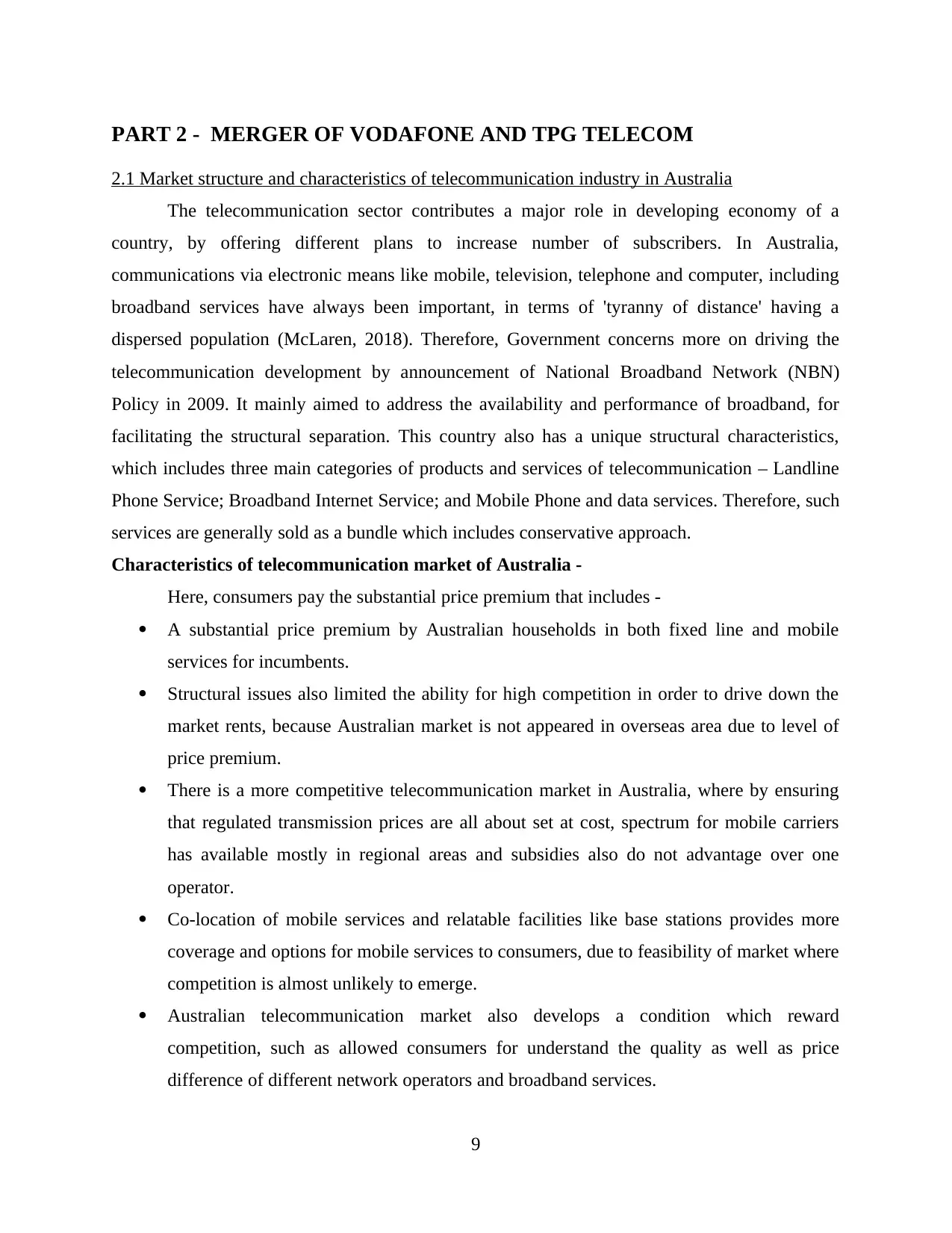
PART 2 - MERGER OF VODAFONE AND TPG TELECOM
2.1 Market structure and characteristics of telecommunication industry in Australia
The telecommunication sector contributes a major role in developing economy of a
country, by offering different plans to increase number of subscribers. In Australia,
communications via electronic means like mobile, television, telephone and computer, including
broadband services have always been important, in terms of 'tyranny of distance' having a
dispersed population (McLaren, 2018). Therefore, Government concerns more on driving the
telecommunication development by announcement of National Broadband Network (NBN)
Policy in 2009. It mainly aimed to address the availability and performance of broadband, for
facilitating the structural separation. This country also has a unique structural characteristics,
which includes three main categories of products and services of telecommunication – Landline
Phone Service; Broadband Internet Service; and Mobile Phone and data services. Therefore, such
services are generally sold as a bundle which includes conservative approach.
Characteristics of telecommunication market of Australia -
Here, consumers pay the substantial price premium that includes -
A substantial price premium by Australian households in both fixed line and mobile
services for incumbents.
Structural issues also limited the ability for high competition in order to drive down the
market rents, because Australian market is not appeared in overseas area due to level of
price premium.
There is a more competitive telecommunication market in Australia, where by ensuring
that regulated transmission prices are all about set at cost, spectrum for mobile carriers
has available mostly in regional areas and subsidies also do not advantage over one
operator.
Co-location of mobile services and relatable facilities like base stations provides more
coverage and options for mobile services to consumers, due to feasibility of market where
competition is almost unlikely to emerge.
Australian telecommunication market also develops a condition which reward
competition, such as allowed consumers for understand the quality as well as price
difference of different network operators and broadband services.
9
2.1 Market structure and characteristics of telecommunication industry in Australia
The telecommunication sector contributes a major role in developing economy of a
country, by offering different plans to increase number of subscribers. In Australia,
communications via electronic means like mobile, television, telephone and computer, including
broadband services have always been important, in terms of 'tyranny of distance' having a
dispersed population (McLaren, 2018). Therefore, Government concerns more on driving the
telecommunication development by announcement of National Broadband Network (NBN)
Policy in 2009. It mainly aimed to address the availability and performance of broadband, for
facilitating the structural separation. This country also has a unique structural characteristics,
which includes three main categories of products and services of telecommunication – Landline
Phone Service; Broadband Internet Service; and Mobile Phone and data services. Therefore, such
services are generally sold as a bundle which includes conservative approach.
Characteristics of telecommunication market of Australia -
Here, consumers pay the substantial price premium that includes -
A substantial price premium by Australian households in both fixed line and mobile
services for incumbents.
Structural issues also limited the ability for high competition in order to drive down the
market rents, because Australian market is not appeared in overseas area due to level of
price premium.
There is a more competitive telecommunication market in Australia, where by ensuring
that regulated transmission prices are all about set at cost, spectrum for mobile carriers
has available mostly in regional areas and subsidies also do not advantage over one
operator.
Co-location of mobile services and relatable facilities like base stations provides more
coverage and options for mobile services to consumers, due to feasibility of market where
competition is almost unlikely to emerge.
Australian telecommunication market also develops a condition which reward
competition, such as allowed consumers for understand the quality as well as price
difference of different network operators and broadband services.
9
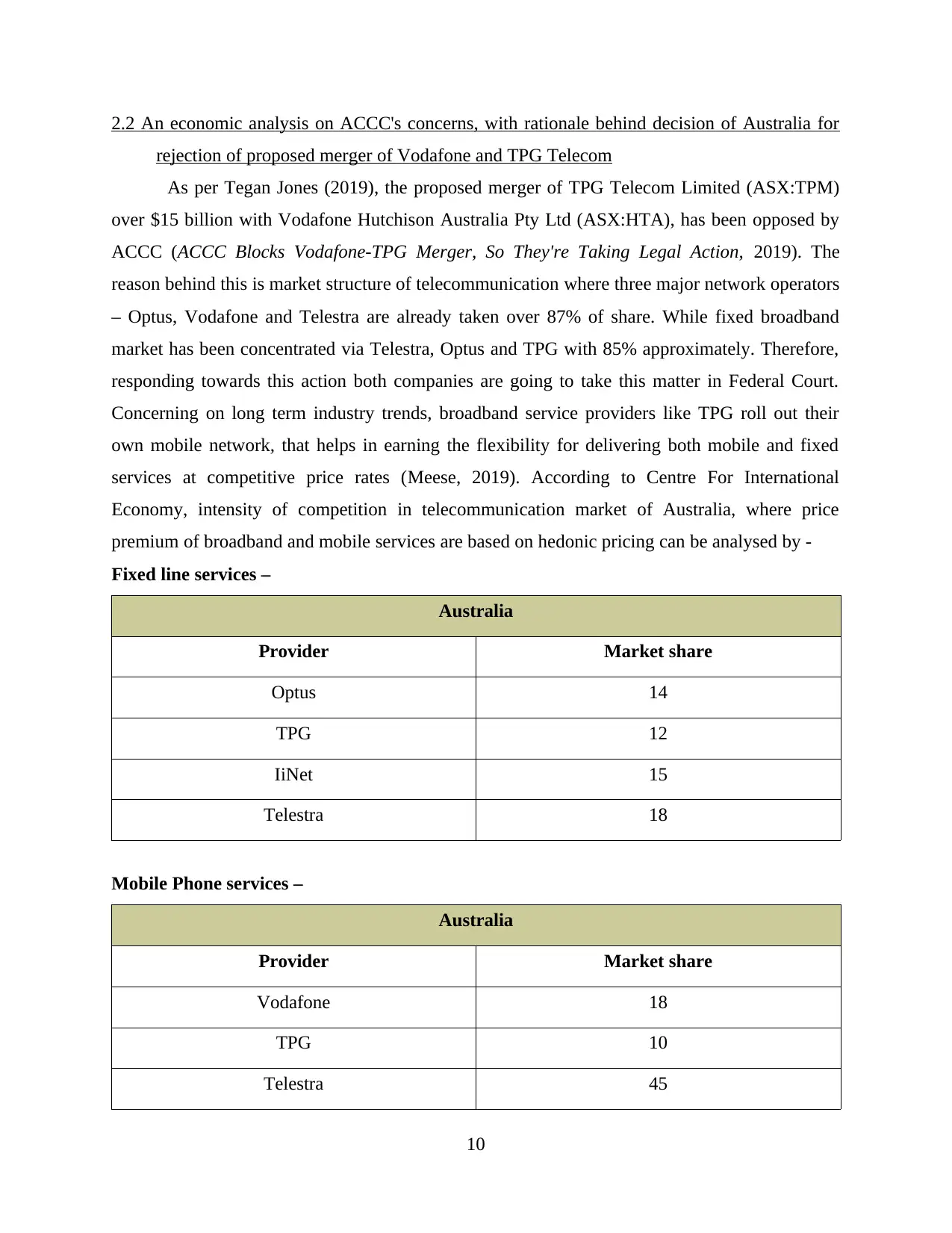
2.2 An economic analysis on ACCC's concerns, with rationale behind decision of Australia for
rejection of proposed merger of Vodafone and TPG Telecom
As per Tegan Jones (2019), the proposed merger of TPG Telecom Limited (ASX:TPM)
over $15 billion with Vodafone Hutchison Australia Pty Ltd (ASX:HTA), has been opposed by
ACCC (ACCC Blocks Vodafone-TPG Merger, So They're Taking Legal Action, 2019). The
reason behind this is market structure of telecommunication where three major network operators
– Optus, Vodafone and Telestra are already taken over 87% of share. While fixed broadband
market has been concentrated via Telestra, Optus and TPG with 85% approximately. Therefore,
responding towards this action both companies are going to take this matter in Federal Court.
Concerning on long term industry trends, broadband service providers like TPG roll out their
own mobile network, that helps in earning the flexibility for delivering both mobile and fixed
services at competitive price rates (Meese, 2019). According to Centre For International
Economy, intensity of competition in telecommunication market of Australia, where price
premium of broadband and mobile services are based on hedonic pricing can be analysed by -
Fixed line services –
Australia
Provider Market share
Optus 14
TPG 12
IiNet 15
Telestra 18
Mobile Phone services –
Australia
Provider Market share
Vodafone 18
TPG 10
Telestra 45
10
rejection of proposed merger of Vodafone and TPG Telecom
As per Tegan Jones (2019), the proposed merger of TPG Telecom Limited (ASX:TPM)
over $15 billion with Vodafone Hutchison Australia Pty Ltd (ASX:HTA), has been opposed by
ACCC (ACCC Blocks Vodafone-TPG Merger, So They're Taking Legal Action, 2019). The
reason behind this is market structure of telecommunication where three major network operators
– Optus, Vodafone and Telestra are already taken over 87% of share. While fixed broadband
market has been concentrated via Telestra, Optus and TPG with 85% approximately. Therefore,
responding towards this action both companies are going to take this matter in Federal Court.
Concerning on long term industry trends, broadband service providers like TPG roll out their
own mobile network, that helps in earning the flexibility for delivering both mobile and fixed
services at competitive price rates (Meese, 2019). According to Centre For International
Economy, intensity of competition in telecommunication market of Australia, where price
premium of broadband and mobile services are based on hedonic pricing can be analysed by -
Fixed line services –
Australia
Provider Market share
Optus 14
TPG 12
IiNet 15
Telestra 18
Mobile Phone services –
Australia
Provider Market share
Vodafone 18
TPG 10
Telestra 45
10
⊘ This is a preview!⊘
Do you want full access?
Subscribe today to unlock all pages.

Trusted by 1+ million students worldwide
1 out of 23
Related Documents
Your All-in-One AI-Powered Toolkit for Academic Success.
+13062052269
info@desklib.com
Available 24*7 on WhatsApp / Email
![[object Object]](/_next/static/media/star-bottom.7253800d.svg)
Unlock your academic potential
Copyright © 2020–2025 A2Z Services. All Rights Reserved. Developed and managed by ZUCOL.





